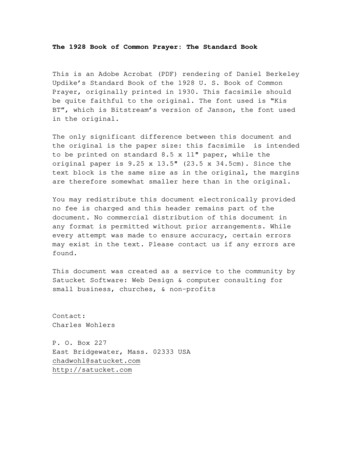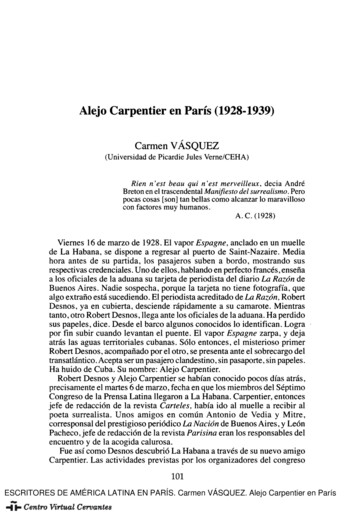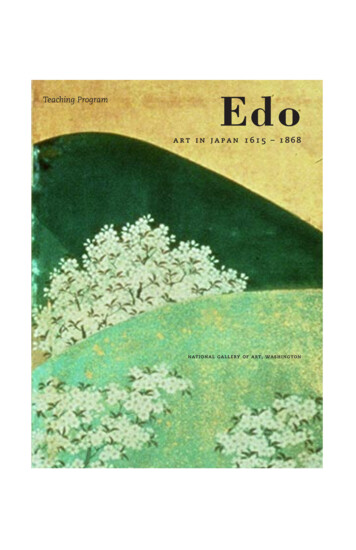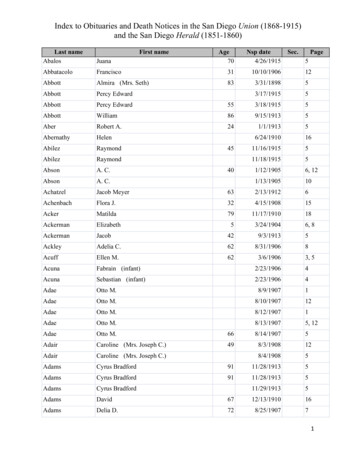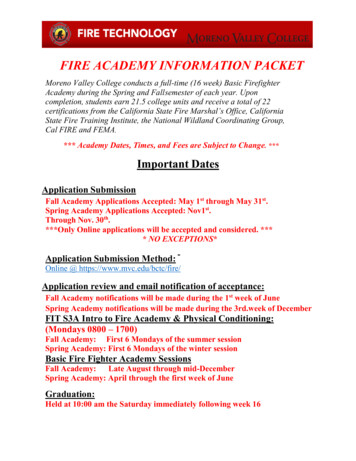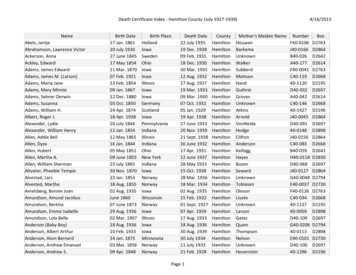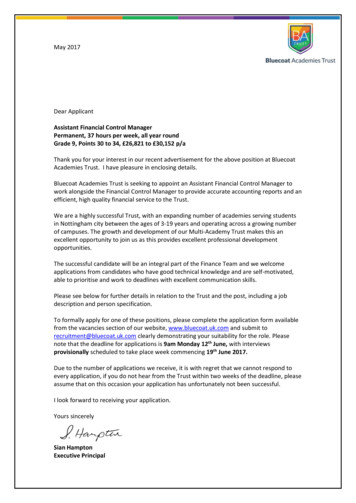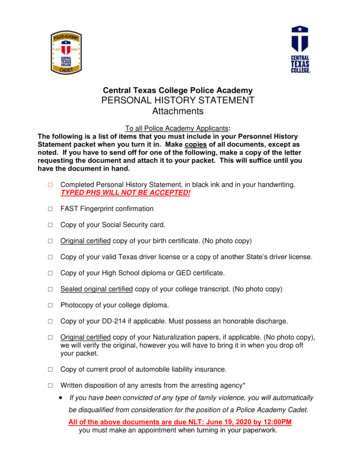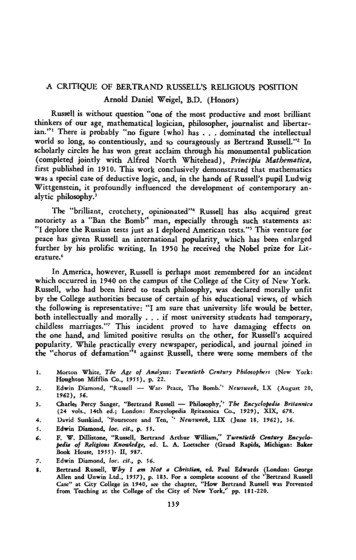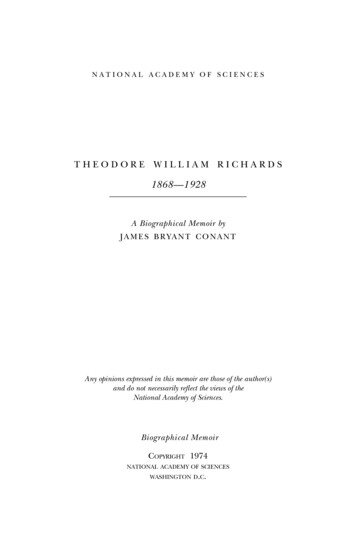
Transcription
national academy of sciencesTheodore william Richards1868—1928A Biographical Memoir byJames Bryant ConantAny opinions expressed in this memoir are those of the author(s)and do not necessarily reflect the views of theNational Academy of Sciences.Biographical MemoirCopyright 1974national academy of scienceswashington d.c.
THEODORE WILLIAM RICHARDSJanuary 31, 1868-April2, 1928BY JAMES BRYANT CONANTwas a precocious son of distinguished parents. He was born in Philadelphia on January31, 1868, the third son and fifth child of William Trost Richardsand Anna Matlack Richards, who had been married on June30, 1856. As strict members of the Society of Friends, theMatlack family looked askance at a young man who earned hisliving painting pictures. Anna was "read out of meeting." TheQuaker marriage ceremony took place in the house of a friend.The first months of the honeymoon were devoted to the composition and illustration of a manuscript volume of poems forthe lady who had first brought the young couple together. Amutual interest in Browning and Tennyson had started anacquaintanceship which rapidly became a romance.An old friend and fellow artist of Philadelphia reminiscinglong after W. T. Richards had established his reputation as alandscape painter said, "He amazed me by getting married andresigning his position as designer [in a local firm manufacturinggas fixtures] in order to devote himself entirely to his art. Idon't remember which event took place first but I thought thelatter extremely unwise—and so it would have been with anyoneelse, but timidity had no place in his nature." Of the struggleof a largely self-taught artist to support a family in the CivilWar years there is little record. By the time the third son,THEODORE WILLIAM RICHARDS251
252BIOGRAPHICALMEMOIRSTheodore, was conscious of his environment, the artist's familywas comfortably settled in Germantown (a suburb of Philadelphia); the summers were spent in Newport, Rhode Island (after1874).Whether the father or the mother had the greater influenceon young Theodore may be argued. But to anyone who examines the few personal documents that are left, there can beno doubt that the future chemist's career was molded at theoutset by his two extraordinary parents. In an article preparedfor a Swedish journal shortly after he was awarded the NobelPrize in 1915, Theodore Richards paid tribute to his understanding mother and father:"Although my parents had no experience with scientific investigation, their tastes and education having been of a verydifferent kind, nevertheless they entered fully into the spirit ofmy desire to undertake it, and were wise enough to see that apossible future lay ahead for me in the path which so profoundly interested me. From that time my father always advised me to devote myself as much as possible to research. Moreover, he supported this advice in a very practical way (realizingthat research in pure science is not a money-getting employment)and offered always to help me, out of his none too plentifulmeans, in case of a pinch, rather than to permit me to engage inthe distracting task of making money by occupations outside ofmy main interest. Later after my marriage in 1896, when newcares presented themselves, and when he saw there was dangerof my overworking, he placed into my hands a sum of moneylarge enough to enable me to feel that I could take a year's restfrom academic work, if that should prove necessary. The relieffrom worry, afforded by this sum in a savings bank, made thevacation unnecessary. There is no question that this generousand thoughtful confidence was a very important factor in thesuccess of a not very optimistic and somewhat delicate youngman, then entirely without any capital except his brains; and
THEODOREWILLIAMRICHARDS253it would be impossible to exaggerate my feelings of gratitude."Quite apart from the wise advice and the financial assistance,William T . Richards must have influenced his third son byhis example. "There was nothing of the pose of his craft abouthim," writes his biographer, "the cast of keen observation inhis face, and the easy grace of his carriage, denoted the man oforiginal thought and unconstrained opinion, the artist whosees a little deeper into objective life than most people, andwhose instincts are, therefore, less confined to convention. . . .He knew he could draw matchlessly, and yet there were elementsin the portrayal of a breaking wave that he never achieved tohis own satisfaction. If you pressed him with commendationon the side of drawing he would shield his modesty behind hisstruggles with that miracle of color under the curving wave. Hehad studied this for years. His son tells us that 'he stood forhours in the early days of Atlantic City or Cape May, withfolded arms, studying the motion of the sea,—until peoplethought him insane. After days of gazing he made pencil notesof the action of the water. He even stood for hours in a bathingsuit among the waves, trying to analyse the motion.' "The words of the son which the father's biographer quotesdemonstrate how much the patience and thoroughness of theartist bent on portraying nature had impressed the boy who sooften stood by while the beginnings of a seascape were forming in the painter's mind. The link between the world ofscience and the world of art was a pride of both father and sonin a capacity to take infinite pains. The chemist who was tobecome famous for the painstaking accuracy of his experimentations may well have received his inspiration from watching hisfather standing hour after hour in the surf.If the influence of the father is largely a matter of conjecture,the role of Theodore's mother in his upbringing is definite andclear. She provided the formal education at home. Her experience with the schools in Germantown had been unsatis-
254BIOGRAPHICALMEMOIRSfactory. Therefore she decided to try the experiment of teaching the younger children herself."We used to have regular hours and school was not to beslighted," Theodore Richards reports in an autobiographicalfragment. Continuing the description, he notes that "drawingand music were included in this home curriculum and so, ofcourse, were reading, writing, arithmetic and geography aswell as much more history than is usually taught to youngchildren. . . . My mother's devotion was tireless and beyondpraise. My debt to her (as well as to my father) is inestimable."He might well so write since not only had his mother's instruction prepared himforentry to the sophomore class at Haverfordat the age of fourteen but her tutoring in Greek (which shelearned for this purpose) a year later enabled him to enroll inthe senior class at Harvard after graduation from Haverford.A typescript composed two years before Richards died isentitled "Early Memories." He ends with an account of hisleaving the summer home near Newport to head for college. Hewas "on his own for the first time," he writes. "With me in mypocket I carried two sonnets written for me by my mother (whowas in many ways a very remarkable and brilliant woman)."Then follow the two sonnets, of which the opening lines of thesecond amount almost to a parental injunction:Fear not to go where fearless Science leads,Who holds the keys of God. What reigning lightThine eyes discern in that surrounding nightWhence we have come, what law that supersedesThe fiat of all oracles and creeds,Thy soul will never find that Wrong is Right;At Christmas 1880, when Richards was not quite thirteen,chemistry had entered his life. He was given a large box containing materials and apparatus for 200 experiments "warrantedto be safe and instructive." Richards has recorded his progress
THEODOREWILLIAMRICHARDS255as a chemical student as follows: "Soon afterwards, when I hadnearly blown off my head with this outfit, I was given Steele'sFourteen Weeks in Chemistry so that knowledge might diminishthe risk; and when the somewhat limited scope of this book hadbeen outspanned, I advanced to Eliot and Storer's ElementaryChemistry which contained a priceless fund of information. . . .Dr. John Marshall of the University of Pennsylvania MedicalSchool was good enough to interest himself in the boy ofthirteen who was so eager for sound chemical knowledge. Heinvited me to Professor Wormley's lectures at the Universityof Pennsylvania."Such was Richards's memory in later years of his introductionto chemistry. At Haverford he first studied the subject with aserious purpose under Lyman B. Hall and decided to becomea chemist. Looking back to that period in his life he recalls that"except for his somewhat defective eyesight he might havechosen to become an astronomer." At this point Josiah ParsonsCooke, Professor of Chemistry at Harvard, whom the familyhad come to know during the summers at Newport, RhodeIsland, enters the story. He seems to have been instrumentalin Richards's decision to spend another year of study and totake a second bachelor's degree at Harvard. Two years laterRichards received the Ph.D. degree for important research onthe atomic weights of oxygen and hydrogen accomplished underProfessor Cooke's guidance. The results were reported in apaper published in 1888 as a joint communication. In the sameyear Richards printed three other papers based on his independent work on the atomic weights of copper and silver, aswell as one dealing with the heat produced by the reaction ofsilver nitrate with solutions of metallic chlorides. Four publications and the young investigator was not yet twenty-one! Thenfollowed a year abroad.Two pieces of research were conducted in the chemicallaboratory of Gottingen University, one in analytical chemistry
256BIOGRAPHICALMEMOIRSunder Paul Jannasch and one on vapor chemistry determinationunder Victor Meyer. In addition some weeks were spent inMunich and in Dresden studying special chemical methods. As asupplement to what Professor Cooke could teach him, theseexperiences seemed to place the young American chemist inthe mainstream of current investigations. They formed an introduction to a far more important semester spent in Leipzig(with Wilhelm Ostwald) and in Gottingen (with Walther Nernst)in 1895. These two periods spent in German laboratories couldbe regarded as Richards's training in the then newly developingfield of physical chemistry. At that period in history therewere no centers of research in physical chemistry in either theUnited States or England. It is not much of an exaggeration tospeak of Richards as a German-trained scientist. His outlookon life, however, was in no sense Germanic. In spite of hisearly and wide acquaintanceship among German chemists anda half year spent in Berlin in 1907, he seems to have found littleto attract him in the empire ruled by the Kaiser. In England,on the other hand, he made lifelong friends. In the summer of1889 he met one of the outstanding chemists, Sir Henry Roscoe(who was a friend of Professor Cooke), as well as Lord Rayleigh,who was soon to become an internationally famous physicist.With the English investigators he felt very much at home. Headmired them and their way of life. It is altogether fittingthat the definitive account of his life is the Theodore WilliamRichards Memorial Lecture delivered by Sir Harold Hartleybefore the Chemical Society of London on April 25, 1929.Richards was elected to the National Academy of Sciencesin 1899. Of all the many honors he received, the award of theFaraday Medal of the Chemical Society of London must havepleased him as much as any. Together with his wife and threechildren he traveled to England in May 1911 for the occasion.Sir Harold Hartley refers to Richards's pleasure at ProfessorH. R. Dixon's allusion to him as the Faraday Lecturer who was
THEODOREWILLIAMRICHARDS257fulfilling Canning's prophecy: "I look to the new world toredress the balance of the old." Honorary degrees from Oxford,Cambridge, and Manchester added to the delight of that summer. T h e Nobel Prize in chemistry awarded in November1915 may be considered as the climax of Richards's public recognition. World War I, however, prevented his going to Swedento receive the award at the time of its announcement. Later aprojected trip had to be canceled because of the sudden illnessof his oldest son, who was to have accompanied him to Stockholm.As much as Richards loved England, and after the invasionof Belgium in 1914 despised all things German, his career asa teacher followed the pattern of Germany. Indeed, a call tothe University of Gottingen in 1902 may be said to have assuredhis position at Harvard. President C. W. Eliot made him a fullprofessor and agreed to the construction of new laboratoryfacilities if and when funds could be raised. (The WolcottGibbs Memorial Laboratory was built for Richards just beforeWorld War I.) Richards desired a few (but only a few) graduatestudents, the professorship of physical chemistry which involvedgiving a full course of lectures, and the privilege of continuinga half course of lectures on "Elementary Theoretical and Physical Chemistry, including the Historical Development of Chemical Theory." This course he had initiated in the 1890s whenhe was still an assistant professor. These teaching tasks Richardsthoroughly enjoyed because he did them well. They were basedon a full confidence in the lecture method, as it was employedin the German universities. As a young man Richards hadbeen responsible for instruction in quantitative analysis. Butby the time he was called to Gottingen he was ready to turn overconcern with this phase of practical chemistry to junior professors whom he had trained. The arrangements which Richards entered into in 1902 at the age of thirty-four remainedunaltered until his death. Though he became famous because
258BIOGRAPHICALMEMOIRSof his many papers describing his researches, his performanceas an excellent and devoted teacher was in itself worthy ofhigh praise.In 1896 Richards married Miriam Stuart Thayer, daughterof Joseph Henry Thayer, a professor at the Harvard DivinitySchool and outstanding New Testament scholar. Thanks to thegenerosity of his father, Richards was able to build a house notfar from the Harvard College yard, in which the couple livedtheir entire married life. There were three children: GraceThayer, who became the wife of the author of this memoir;William Theodore and Greenough Thayer, both of whom became professors, the one of chemistry at Princeton, the other ofdesign at Virginia Polytechnic Institute. The summer monthswithout fail were dedicated to a vacation, often on Mt. DesertIsland in Maine. The health of both father and mother wassomewhat precarious but the duties of the professor of physicalchemistry were carried out without fail year after year. Onlyfor half a year in 1907 did Richards absent himself from Cambridge in order to function as the Exchange Professor at Berlin.There were no leaves of absence for reasons of health, andRichards never availed himself of the privilege of taking a halfyear's sabbatical at full salary. He could not bear to be separatedin term time from his graduate students whose experimentationshe followed almost daily with a discerning yet sympathetic eye.The habit of attempting to forsee all possible contingencies,which was basic to his success as a scientific investigator, placeda heavy strain on his life as a husband and father. To worryabout the smallest detail was to be a painstaking chemist settingnew standards of accurate measurement. Yet to carry over todaily life the same attitude condemned the scientist to a totallife of anxiety. As he approached sixty it became apparent to hisclose relatives that the nervous load Richards had been carryingfor years was too much for the physical organism. Yet hecontinued his lectures and went to his laboratory on his regular
THEODOREWILLIAMRICHARDS259schedule until within a few days of his death, which occurredon April 2, 1928. He went down with his colors flying as hadbeen his wish.RICHARDS'S SCIENTIFIC WORK[Richards left an account of his scientific work up to the year1914. The first portion of the document deals with his investigations of atomic weights. I have printed it as part of an articleon "Theodore William Richards and the Periodic Table"(Science, Vol. 168, pp. 425-28, April 24, 1970). For the sake ofcompleteness I reproduce it here and it constitutes the balanceof the text of this memoir. The entire autobiographical fragment is written in the third person. The part which has not yetbeen published starts with his evaluation of his work on chemical thermodynamics. I have to thank my wife for making themanuscript available.]The scientific work of Theodore W. Richards may bedivided for convenience into five categories more or less closelyinterrelated. Thefirstof these categories includes the study ofatomic weights, the second, the investigation of various problems concerning chemical equilibrium, the third, original workupon chemical thermodynamics both practical and theoretical,the fourth, the study of various problems in electrochemistry,and the fifth both practical and theoretical work concerning thesignificance of atomic compressibility and the changes exhibitedby atomic volumes under varying conditions.During the past twenty-six years Richards has been directlyconcerned in the study of the atomic weights of twenty elements,and some of his pupils at Harvard have independently studiedten more. Thus far no one has been able to show that any oneof the investigations concerning these thirty elements is seriously in error, and the results of all have been accepted as thebest heretofore published by the International Committee on
260BIOGRAPHICALMEMOIRSAtomic Weights, which has no Harvard representative upon it.The elements investigated under the immediate direction ofRichards or with his own hands are as follows: oxygen, copper,barium, strontium, zinc, magnesium, nickel, cobalt, iron, uranium, calcium, caesium, chlorine, bromine, silver, sodium,potassium, nitrogen, sulphur, and lithium.The determination of the ratio of oxygen to hydrogen wastaken up in collaboration with J. P. Cooke in 1886. Theyweighed hydrogen directly in large glass globes, and after havingburnt it with copper oxide, determined the weight of water.The outcome gave a result for hydrogen only 0.0004 differentfrom the value 1.0078 now generally accepted. This was thefirst direct determination showing that the ratio of hydrogento oxygen is distinctly less than 1 is to 16, and the error in theresult was one-half as large as the error that was previously considered as the best.The behavior of copper oxide led Richards to suspect thatthe atomic weight of copper accepted at that time was in error,and accordingly he commenced an investigation of this elementwhich lasted four years. He discovered that oxides of metalsprepared from the nitrate always contain included gases, a circumstance which he found to vitiate the earlier work not onlyupon the atomic weight of copper but also those of a numberof other elements. He showed also that the copper sulphate hadmuch greater tendency to retain water than had been attributedto it, and by means of a number of new methods obtained aseries of consistent results for the atomic weight of copper. Therelation of copper to silver, of copper to bromine, and of copperto sulphuric acid were all determined with care, and all yieldedessentially the same new value, thus leaving no doubt that theold value for copper was nearly one-half a percent too low.The anomalous behavior of barium sulphate led Richardsthen to study the atomic weight of barium; both barium chlorideand barium bromide were analyzed taking care to drive off all
THEODOREWILLIAMRICHARDS261the water without decomposing the salts. Much time was spentupon the preparation of pure silver and every step of the analysiswas tested taking great heed especially of the solubility of silverchloride. The result showed that barium was previously almostas unexact as copper. In this case as in the other not only werenew results obtained but also the reasons for the deviations in theold ones were made clear.Strontium, magnesium, zinc, nickel, cobalt, iron, uranium,and caesium were then taken up in succession, being studiedby somewhat similar methods with the help of the experiencegained in the earlier researches. In some of these Richards hadthe assistance of pupils. He was able to show that the old resultson zinc and magnesium were in error because of the retentionof gases on the oxides, and that most of the other values alsohad been vitiated by chemical imperfections in the methodsemployed. Richards not only employed and revised the oldmethods but devised new ones in the course of this work.The investigation upon caesium marked the end of thefirst period of his investigations concerning atomic weights—the time during which the work of Stas had been consideredimpeccable. In 1904 the investigation of a large number ofspecimens of sodium bromide while verifying Stas's atomicweight for bromine seemed to indicate that this value for sodiumwas distinctly too high. Because the sodium bromide underwent transition from the dihydrate to the anhydrous salt at aperfectly definite point, it was evidently very pure. Hence itsverdict could not be ignored and a new study of the atomicweight of sodium was undertaken. This investigation began anew period in Richards's work in which he was able to showthe errors into which Stas had unwittingly fallen. He provedwithout question that not only was Stas's value for sodium toohigh but his value for chlorine was too low, and both of theseconclusions have been verified by the subsequent work of others.Because Richards had previously chiefly used bromides, this
262BIOGRAPHICALMEMOIRSdiscovery of the error in chlorine was not made during hisearlier researches.The discovery of error in two of Stas's most accurately determined results led to the natural suspicion that others alsomight need revision. Accordingly three determinations ofpotassium, of sulphur, and of nitrogen were undertaken withthe help of able assistants, the last of the three investigationsbeing conducted partly at the University of Berlin during theterm of his exchange professorship there. Potassium chlorideand bromide were both analyzed with all the care used in the caseof sodium. Sulphur was approached by a new method involvingthe conversion of silver sulphate into the chloride, and nitrogenwas attacked both by the synthesis of silver nitrate and by theanalysis of ammonium chloride. The work on silver nitratewas in some ways the most convincing of all, because in thiscase it was possible to prove that the salt was essentially freefrom water, by decomposing it and passing the products ofdecomposition, suitably treated, through a phosphorus pentoxide tube. No more concordant results have ever been securedin the Harvard Laboratory than the six successive experimentsby which the silver was converted into silver nitrate—the extreme variation between the results being less than one-thousandth of a percent. If any error existed in them, it was an errorof amazing constancy.The most recent finished problem with which he has beenconcerned was a study of the atomic weights of lithium, andsilver. Not only was the ratio of lithium chloride to silver determined but also its ratio to silver chloride and besides this bya new method the amount of lithium chloride contained inlithium perchlorate was carefully determined. The ratio ofsilver to oxygen was thus directly obtained by this equation.AgLiClAgXLiClLiClO4 - LiCl O 4
THEODOREWILLIAMRICHARDS263This was entirely a new procedure and for many reasons seemsto give one of the very best means of determining the atomicweight of silver. Incidentally the atomic weight of lithium wasfound to be almost a whole percent less than that obtained byStas. This seems to have been Stas's most grievous error, andcame to pass only because all the defects in his process accumulated on the head of this lightest of all the metals.Richards has himself said that "the secret of success in thestudy of atomic weights lies in carefully choosing the particularsubstances and processes employed, and in checking everyoperation by parallel experiments so that every unknown chemical and physical error will gradually be ferreted out of itshiding place. The most important causes of inaccuracy are: thesolubility of precipitates and of the material of containingvessels; the occlusion of foreign substances by solids, and especially the presence of retained moisture in almost everything.Each of these disturbing circumstances varies with each individual case. Far more depends upon the intelligent choice of the conditions of experiment than upon the mere mechanical execution of the operations, although that too is important." Incarrying out these suggestions he has brought into play all thepowerful aid furnished by the new science of physical chemistrywhich has thrown so much light upon the mechanism of theestablishment of chemical equilibrium. He has always heededthe advice given in the paragraph above, especially the seriesof errors caused by the unsuspected presence of water in thesalts to be weighed. With this in mind there was evolved in thecourse of this work a remarkably simple device for driving offevery trace of water from any salt, and then enclosing this saltin a bottle without exposure for an instant to the outside airso that it could be weighed without risk of attracting moisture.This device greatly helped his work as did also the nephelometer,an instrument for detecting minute traces of suspended precipitate by means of the light reflected by them. Both of these
264BIOGRAPHICALMEMOIRSinstruments were original with him. He has always pointedout very emphatically that the chemical difficulties in work ofthis kind greatly exceed the physical ones. The operation ofweighing is far more easily controlled than the solubility ofprecipitates and the retention of foreign substances in the material to be weighed. For this reason he has preferred to userather small quantities of material and to prepare these in astate of undoubted purity. As he has pointed out, there is noobject in weighing 100 grams of material even to within 5milligrams, if it contains as much as 0.01 percent of impurity.A much better result can be obtained by weighing 10 gramsto within 0.1 of a milligram, provided that the material itselfcontains no more than 0.001 percent of impurity.Richards's contributions to the science of chemical thermodynamics have been varied in nature, and, as in the other cases,they have had in part a practical interest and in part also primarily a theoretical one; his first published paper was a briefstudy of the constant heat of precipitations of argentic chloride,now so well explained by Arrhenius's theory. Subsequently hehas studied a wide variety of thermochemical phenomena withunusual precision, having devised entirely a new method ofcalorimetry for this purpose. This method, first put in practiceby him, consists in causing the environment of the calorimeterto change in temperature at precisely the same rate as the calorimeter itself. Thus at one stroke the various corrections forcooling, and for the lag of the thermometer, are wholly eliminated, and a more satisfactory thermochemical result is obtainedthan can be reached in any other way. With the help of pupils,he has applied this method to the determination of the specificheats of solids at low temperatures, the specific heats of liquids,the heats of solution of metals in acids, and the heats of combustion of organic substances, having obtained a great varietyof data upon these various topics, many already published and
THEODOREWILLIAMRICHARDS265many awaiting publication. He has been able to show in mostcases that others have made greater or less important errors intheir work, for example, in the case of the determination ofspecific heats of solids when corrected for the heat loss or gainduring transfer by running parallel experiments with a hollowvessel of the same bulk and same material as the sold piece ofmetal to be measured, thus making possible by mere subtractionthe accurate correction for this error. He was also able to provethat Julius Thomsen's methods for correcting the results withconcentrated solutions to those with dilute solutions was incorrect in detail.In his study of the specific heats of the elements at lowtemperatures he emphasized especially the rapid falling off ofthe specific heat with the temperature in many cases, a phenomenon recently taken up more in detail and at even lowertemperatures by Walther Nernst. His study of heat capacities,however, was not limited to the practical laboratory work. Ina paper, which deserves especial mention because it has beenfrequently overlooked, he pointed out on the basis of such dataas were available at that time that the change of heat capacity of'a reacting system was in all probability connected with the difference between the total energy change and the free energychange in that reaction. He was the first to point out that in allprobability the two latter quantities are equal to one another incase no change of heat capacity occurs during the reaction, andhe also pointed out that in all probability an increase in heatcapacity during a reaction signifies that the total energy changeis less than the free energy change, whereas, on the other hand,a decrease in the heat capacity during the reaction probablycauses the total energy change to be greater than the free energychange. These statements clearly made in 1902 are withoutquestion the basis of Nernst's subsequent mathematical treatment of the subject. Richards' data were rather inadequate and
266BIOGRAPHICALMEMOIRShis paper tentative, but the essential ideas involved are unquestionably outlined in this paper, although not treated there infull detail.Electrical problems wer
January 31, 1868-April 2, 1928 BY JAMES BRYANT CONANT THEODORE WILLIAM RICHARDSwas a precocious son of distin- guished parents. He was born in Philadelphia on January 31, 1868, the third son and fifth child of William Trost Richards and Anna Matlack Richards, who had been married on June 30, 1856.
